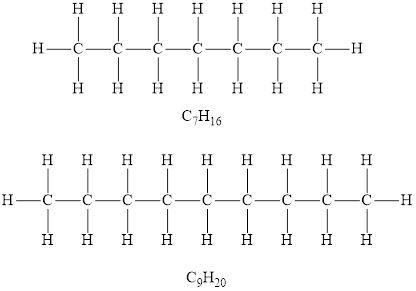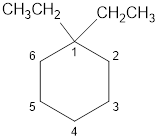
Concept explainers
(a)
Interpretation:
From the following hydrocarbons, alkane is to be identified.
Concept introduction:
Hydrocarbons contain carbon and hydrogen atoms.
Answer to Problem 21.3TC
Among the given hydrocarbons
Explanation of Solution
Alkanes are the saturated hydrocarbons in which each carbon atom is bonded to four other atoms via single bond only. The alkanes general formula of is
According to the general formula of alkanes, for 7 carbon atoms there must be 16 hydrogen atoms and for 9 carbon atoms, there must be 20 hydrogen atoms. Hydrocarbons

According to the general formula of alkanes, for 5 carbon atoms there must be 12 hydrogen atoms and for 11 carbon atoms, there must be 24 hydrogen atoms. Hydrocarbons
Among the given hydrocarbons
(b)
Interpretation:
The formula of the alkyl group derived from pentane is to be identified.
Concept introduction:
An alkyl group is derived from the respective alkane. Alkyl group is an alkane with one hydrogen atom less than the respective alkane. The alkyl group is named after alkane counterpart containing the same number of carbon atoms by replacing the “ane” suffix to “yl”.
Answer to Problem 21.3TC
The formula of the alkyl group obtained from pentane is
Explanation of Solution
The molecular formula of pentane is

The formula of the alkyl group derived from pentane is
(c)
Interpretation:
The structural diagram of
Concept introduction:
Lewis diagram is the representation of the molecules or ions. It shows the bonding between the atoms and also shows the unshared pairs of electrons on an atom if any. The structural formula or structural diagram is nothing but Lewis structure without unshared pairs of electrons.
In the IUPAC name of an organic compound represents the number of the substituent and the numbers before the Greek prefix represent the position of the substituents. The suffix for an alkane is ‘ane. The number of carbon atoms in the parent hydrocarbon chain is represented by the root name. For example: ‘prop’ represent 3 carbon atoms present in the parent hydrocarbon chain.
Answer to Problem 21.3TC
The structural diagram of

Explanation of Solution
The IUPAC name of the hydrocarbon is
The structura diagram is,

The structural diagram of

(d)
Interpretation:
The structural diagram of
Concept introduction:
Lewis diagram is the representation of the molecule or ion. It shows the bonding between the atoms and also shows the unshared pairs of electrons on an atom if any. The structural formula or structural diagram is nothing but Lewis structure without unshared pairs of electrons.
In the IUPAC name of an organic compound, the Greek prefix represents the number of the substituent and the numbers before the Greek prefix represent the position of the substituents. The suffix for an alkane is ‘ane and the prefix ‘cyclo’ is used for cycloalkanes. The number of carbon atoms in the parent hydrocarbon chain is represented by the root name. For example: ‘prop’ represent 3 carbon atoms present in the parent hydrocarbon chain.
Answer to Problem 21.3TC
The structural diagram of

Explanation of Solution
The IUPAC name of the hydrocarbon is

The structural diagram of

Want to see more full solutions like this?
Chapter 21 Solutions
Introductory Chemistry: An Active Learning Approach
 Chemistry: The Molecular ScienceChemistryISBN:9781285199047Author:John W. Moore, Conrad L. StanitskiPublisher:Cengage LearningChemistry: Matter and ChangeChemistryISBN:9780078746376Author:Dinah Zike, Laurel Dingrando, Nicholas Hainen, Cheryl WistromPublisher:Glencoe/McGraw-Hill School Pub Co
Chemistry: The Molecular ScienceChemistryISBN:9781285199047Author:John W. Moore, Conrad L. StanitskiPublisher:Cengage LearningChemistry: Matter and ChangeChemistryISBN:9780078746376Author:Dinah Zike, Laurel Dingrando, Nicholas Hainen, Cheryl WistromPublisher:Glencoe/McGraw-Hill School Pub Co Organic And Biological ChemistryChemistryISBN:9781305081079Author:STOKER, H. Stephen (howard Stephen)Publisher:Cengage Learning,
Organic And Biological ChemistryChemistryISBN:9781305081079Author:STOKER, H. Stephen (howard Stephen)Publisher:Cengage Learning, General, Organic, and Biological ChemistryChemistryISBN:9781285853918Author:H. Stephen StokerPublisher:Cengage Learning
General, Organic, and Biological ChemistryChemistryISBN:9781285853918Author:H. Stephen StokerPublisher:Cengage Learning Chemistry for Today: General, Organic, and Bioche...ChemistryISBN:9781305960060Author:Spencer L. Seager, Michael R. Slabaugh, Maren S. HansenPublisher:Cengage Learning
Chemistry for Today: General, Organic, and Bioche...ChemistryISBN:9781305960060Author:Spencer L. Seager, Michael R. Slabaugh, Maren S. HansenPublisher:Cengage Learning





